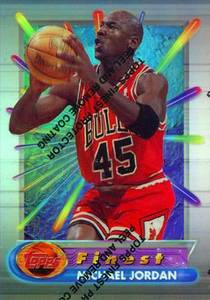In 2016 a series of never before seen cards became available for sale. The 1994-95 Finest #331 card normally shows Jordan wearing his #45 comeback jersey but these cards which surfaced in 2016 depicted him in the same photo only with the #23 jersey. I reached out to a couple of sellers who had listed cards for sale and posted my conversation with one at the time.
The $4.5k (inc buyer’s premium) Goldin sale reminded me I had been meaning to take a much more in-depth look at the card and detail my theory on how it came to be.
Before we get started, here’s the cards we are looking at - first the #23 jersey version then the regular issue version #45 jersey.
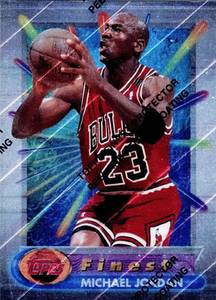

A close look at the 94-95 Finest Jordan wearing #23 jersey.
Let’s take a close look at both the front and the back of each of the #23 and #45 jersey cards.
Differences on the front
The most notable difference between the two cards, aside from the jersey number change, is the series of diagonal marks. These evenly spaced marks appear to soften slightly where the photograph is printed. Take a look at the close-up below and note the way the diagonal lines appear to run under Jordan’s hands and head but show through the ball and background nicely.
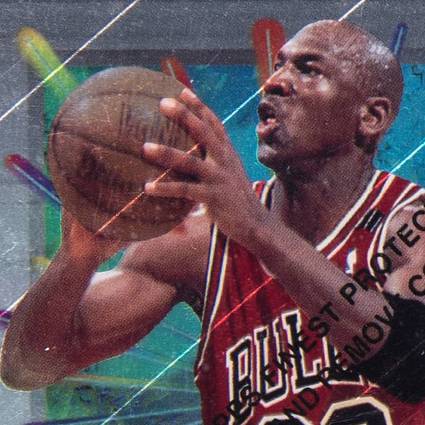
The marks additionally do not appear to affect the peel as shown in this close-up. In fact we can see that they appear to have a 3D effect.
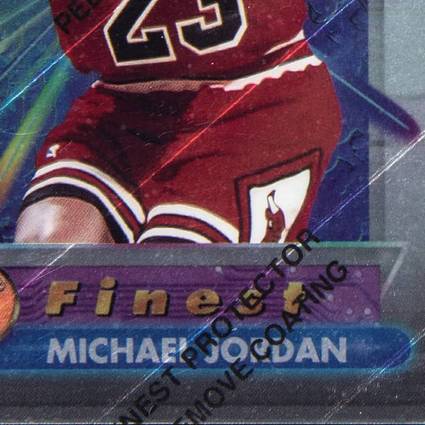
In addition to the diagonal lines on the #23 card, we can see Jordan is wearing a mourning band on his left shoulder which has been removed on the #45 card. The Bulls wore this band in the latter part of the 91-92 season in honour of Sheri Berto, a long time Bulls employee, who passed away on November 23, 1991. The Bulls also wore a mourning band in the 1989 playoffs - I haven’t found for whom this was in honour.
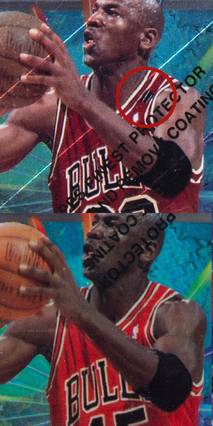
Differences on the back
The diagonal lines do not appear on the back of the card. We do, however, see the photo of Jordan used on the back does also feature the mourning band as per the front, again removed for the #45 card.
Additional to the mourning band, Jordan’s FGM is shown incorrectly on the #23 card at 8089 and correctly on the #45 card at 8079.
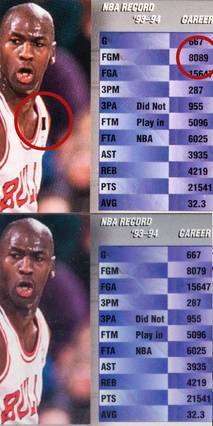
Finally we can see that the #23 jersey card does not include the final notice “Skin Protector Pat. Pending” whereas the #45 card does. This is interesting in it’s own right.
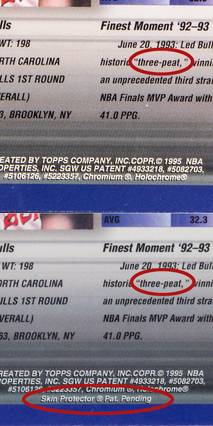
Also worth noticing here is what looks like a typo on both cards “three-peat,” - the comma should be outside the quote mark.
Skin Protector Pat. Pending
This notice was included on the #45 jersey card and excluded from the #23 card. However no other series 2 card features the notice.
It is not globally included in series 1 cards either. The distribution of base and subset cards which include the patent pending notice are:
- 1-10
- 17-55
- 101-110
- 115-165
- 331 (the only series 2 card to include it is the Jordan)
There’s some patterns to the inclusion here. First we see that all subset cards do feature the notice. Secondly, cards #55, #110 and #165 are the last cards when grouping the set into three groups. The fact that the cards leading toward the end of each of these groupings is interesting.
It’s possible the patent application took place after design and layout of the cards commenced. If this was the case this notice may only reach cards not yet designed. Perhaps 3 different designers were tasked with laying out a group of 55 cards each and began to include the notice partway through their work toward the end of their own card composition.
However, a late inclusion in series 1 doesn’t explain why no series 2 cards include it except the Jordan #45 jersey. Presumably, all series 2 cards would have been designed with the latest template. Or perhaps the patent had been awarded by this time and the notice accidentally made it onto the Jordan #45 jersey card - however shouldn’t we expect to see an additional patent number in this case?
On top of that, we can see that the jersey #23 card did not include it so why did Topps go to the effort to add it to the #45 jersey card when no other series 2 cards included the notice?
Copyright notice
All series 1 cards feature a copyright 1994 notice. All series 2 cards - including both #23 and #45 jersey number 331 Jordan cards - feature a 1995 copyright notice. This tells us the Jordan #23 is unlikely to have been produced in 1994.
Team distribution
If we look at the distribution of team representation through the base (excluding subset and insert) cards we can see a range of 9 - 11 cards for each team. No team has 12 cards except the Chicago Bulls once we include the #331 Jordan.
Card number 331
A set of 331 cards is not something likely to have been planned. Cards are printed in large sheets - in Topps’ case for this season 110 cards per sheet for the base (including subset) card set. We know that multiple cards were printed per sheet as shown below yet the Jordan #331 cards were all printed on a single sheet.

Topps’ releases
There was no Jordan released as part of 94-95 Topps regular or Stadium Club issue. We have only this Finest card and a Jordan as part of the Embossed set from Topps. It’s worth noting that the Topps Embossed Jordan is also the last card in the set and an unusual number at #121.
There was a 94-95 Stadium Club Members Only 50 Jordan - in this card he’s wearing jersey number 23 with the card talking about his impact upon return to the Bulls 🤨.
94-95 Topps Finest printing
Let’s take a quick look at how the early Finest cards were produced. Jim Esker gave an interview on the Wax Museum podcast in 2020 and discussed the method. The process was designed when he was at Signs and Glassworks (SGW) which you can see credited on the back of many cards using their Chromium production method.
Through listening to Jim, talking with printing experts and reviewing the patents documents (4933218, 5082703, 5106126, 5223357) I believe I can summarise the printing process to:
- The front of the card is printed in reverse on clear plastic
- White ink is then used to ‘knockout’ or soften any area behind the colour that the silver foil shouldn’t show through
- ‘Extraordinarily’ thick clear ink is then used is used to create the texture lines
- Silver or Refractor foil is laminated to the reverse of the plastic sheet which bends over the clear ink to create the texture on the reverse side (this is why you cannot feel the texture on these cards but can see it through the image)
- A backing is applied along with the back of the card printed on paper
- The peel is applied to the front
- The sheet is cut into individual cards
The images below show sample #331 Finest Jordan cards which have reached the foil laminating stage. You can see how the clear ink affects the foil and creates the texture on the reverse of the colour image.
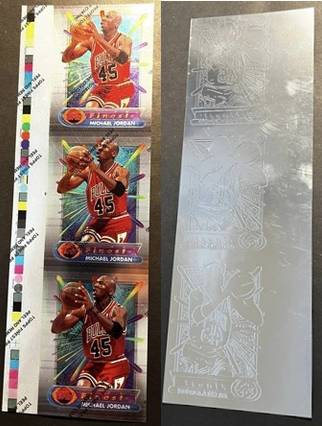

We can see some of this process on the Iron Man and Marathon Man inserts. These follow a similar process without foil or backing card applied - here the back of the card is printed to the plastic substrate.
Texturing
Taking note of the printing process, we can see a further variation when we compare the #23 and #45 jersey cards - the #23 jersey card doesn’t appear to have any texturing applied. I don’t own one to take a close look at but all high resolution scans I’ve looked at appear to show no or very little texturing appearing through to the front of the #23 card (scanning methods can appear to flatten the texturing on these which could be the case on the #23 jersey cards I’ve looked at).
Designing the texture would have been a graphic design task secondary to the design of the photo. Perhaps this is evidence that the full design process had not occurred by the time the #23 jersey cards were printed.
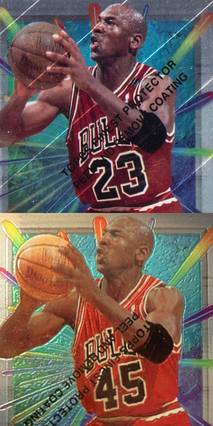
Diagonal texture?
This point leads us full circle back to our initial observation - the diagonal lines. Due to the way the diagonal lines appear to run under the colour image, and taking into account what we know about the printing method with respect to the knockout and softening of the foil, I believe these lines were printed in place of the proper texturing.
If every sheet was required to go through the texturing ink stage (the ‘extraordinarily’ thick clear ink we mentioned earlier) then it makes sense that there would need to be a default texture for use when no texture had been designed as yet. This could also act as a quality control method making it easy to identify any sheets which did not have its texture applied. I do not have access to a card to check in person but this looks to me to be the case based on high resolution imagery I’ve seen.
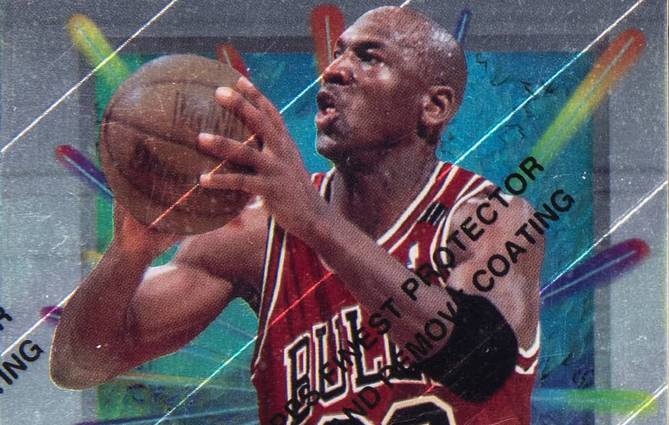
The lead-up to 94-95 Finest series 2
It’s worth revisiting what was happening at the time in the lead-up to the 94-95 Finest series 2 release - a time when packs were being ripped in search of a Michael Jordan baseball card.
After his retirement in late 1993, the 93-94 season of the NBA was played without Michael Jordan. As a result, due to his exclusive contract with Upper Deck signed in 1992, there would be no 1994-95 basketball cards produced by any other company.
That is, unless of course, Jordan was playing in the NBA.
Jordan’s baseball tenure
By early 1995 Jordan’s baseball career was slowly progressing from humble beginnings toward major league prospects. He told Chicago Tribune’s Bob Greene:
“I’d like to get to the majors and play for a couple of years. That’s how I’d like it to end - earning my way to the White Sox, and being a true major-league player for two or three years, and knowing that I’ve accomplished what I set out to do. But whether that works out, or I fall short, no matter how it ends, I’ll walk away with a smile.”
But Major League Baseball’s eighth and longest labour strike would get in the way - even though Jordan wasn’t playing in the majors at the time.
The MLB strike
While Jordan’s fame had a clear impact on the box office, including speculatively when he was rumored to be headed to the Sounds, there was an understanding that he would not be paraded as a strike replacement in the majors in order to sell tickets. He told Bob Greene:
“The one promise that was made to me was that they wouldn’t put me in the position of being a strikebreaker - that if there were games in spring training that would be considered strikebreaker games, I wouldn’t be asked to play in them.”
The risk of this promise being broken inched along as the MLB strike continued to close in on the start of the regular season. Come April 1995, major league teams could fill their rosters with replacement players from the minor league.
NBC Sports reported these players were better known in the labour world as strikebreakers or scabs. And Jordan did not want to be a scab.
Thankfully, White Sox management agreed that Jordan should not go against the union. NBC Sports quoted General Manager Ron Schueler:
“I wouldn’t ask Michael to (play as a replacement player). He’s too high profile and I know he wouldn’t cross.”
If only it was that easy. You see, while Jordan and management agreed he should not play as a strikebreaker, they didn’t expect the Major League Baseball Players Association to move the goal posts on what constituted strikebreaking.
On February 19 1995 Don Fehr, head of the MLBPA said:
“Our view is that any spring training game that is played at either the major league site or for which admission is charged is a replacement player.”
This statement meant Jordan would be a scab if he played in March just as much as if he played in April and he intended to stick with the union.
White Sox owner Jerry Reinsdorf countered Fehr stating of minor league players: “They’re not members of the union. They’re just being asked to do what they normally do, which is to play in spring-training games.”
This disagreement would set the stage for Jordan’s departure from baseball and unfortunately he didn’t get to “walk away with a smile”.
The parking dispute
The spill-over of the major league crisis into the minor league continued when White Sox management began sending home an minor league players who refused to act as replacements. There was no right answer for most of the minor league players caught in the middle as Jordan described to Bob Greene:
“So what you have is these young guys caught totally in the middle, with no one they can turn to. Yeah, I was mad - I was as mad as I’ve ever been.”
To make matters worse White Sox management reserved the players parking lot only for major leaguers. Jordan continued to Greene:
“They made a rule that if you wouldn’t play in Sox games, then you couldn’t park your car in the lot. You had to park down the street. Schueler had to know that for me, that meant something completely different than for the other players.”
The players parking lot was fenced and patrolled by security. Obviously parking in the street was going to be a significant problem for someone as well known as Michael Jordan. Walking to and from the ballpark via the street every time he attended would have meant mobs of crowds waiting. Not to mention the unsecured car sitting on the open street.
White Sox management made it clear that no one was exempt from the expectation that they would be used as replacement players.
After this final straw Greene reports that:
One day Schueler was seen out on the practice field talking animatedly with Jordan. Jordan appeared furious. … Jordan walked silently toward the clubhouse. Within the hour he was gone from camp.
With “…considerable thought and with sadness and disappointment…” Michael Jordan announced his retirement from baseball on March 10 1995.
The rumour mill kicks off for a return to the Bulls
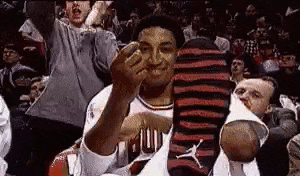
Phil Jackson was confident Jordan would be back, in fact he had started broaching the idea as early as September 1994. Jordan’s presence training with the Bulls once he was no longer in baseball certainly got tongues wagging.
By early March 1995 - before Jordan had even officially left baseball - the media was ablaze with Jordan return rumours. On March 9 the Chicago Tribune ran an article titled ‘It’s Michael mania’ reporting on his workouts with the Bulls. The very next day it was official MJ was done with baseball and it truly was Michael mania. Box offices of teams soon to face Chicago on the road lit up selling thousands of extra tickets.
Even President Bill Clinton had something to add:
“As of today, the economy has produced 6.1 million jobs since I became president and if Michael Jordan goes back to the Bulls, it will be six million, one hundred thousand and one new jobs.”
That same night Scottie Pippen made his famous televised gesture wearing Air Jordans as the Bulls beat the Cavaliers at home by a fitting 23 points.
As we now know, on Saturday March 18 1995 Jordan issued his famous “I’m back.” statement via fax. The following night he wore number 45 for the Bulls against the Pacers dropping 19 points in his first NBA game in 21 months.
How did we end up with a 94-95 Finest Jordan card wearing #23 jersey?
That’s a long, but important, prelude to my theory about how we ended up with the #23 jersey 94-95 Finest Jordan card.
I pulled the Jordan #45 jersey card in my first pack of 94-95 Finest. In fact, it also contained the Glen Robinson rookie card #166 which I thought was cool - two stars and the first and last card of series 2 in my first pack of Finest for the series.
Though I was buying the packs, I don’t recall the date of release of series 2 Topps Finest 94-95. As mentioned, we can see that there was no Jordan card as part of the regular 94-95 Topps release however both Finest and Embossed include the Michael Jordan card as the final and unusually numbered card in the sets.
Given Upper Deck’s exclusive agreement with Jordan, Topps would not have been able to produce a Jordan basketball card unless he was playing in the NBA. The absence of a regular issue Topps card while Finest and Embossed cards exist tells us that Finest and Embossed came to completion after the regular Topps release. The unusual card number #331 (and #121 in Embossed) tells us that the sets were planned before the Jordan card was appended to the end. This is further backed up by the team distribution and difference with series 2 regarding the patent pending notice.
I mentioned the release date as it would be useful to know with certainty. Topps would certainly do everything possible to get a Jordan into their basketball sets as an NBA player - particularly their flagship release.
We can clearly see some haste in the production of the #23 jersey card. The jersey is the wrong number, the texture is incomplete, there’s a typo and the data contains an error. I believe these cards were prototype proofs rushed through the process for approval to make it to the release of series 2. Either the rumour mill or his official retirement from baseball were the impetus for Topps to quickly produce and test a prototype.
Whether rumour or officially prompted, this is a prototype printed before the final airbrushing and texturing had been completed. The #23 jersey photo could have been chosen as it was a good candidate for easy airbrushing the #45 or Topps simply didn’t know he would wear a different number yet. The airbrushing away of the mourning bands is likely to have been done to ensure the photo isn’t easily dated back to a time the Bulls wore it - attention to detail on Topps’ part.
I’ve heard theories that the #23 card was a promo but I don’t believe this to be true. For me, it has all the hallmarks of a prototype rushed through production.
I’ve found no evidence either way whether these were cut by Topps or from a sheet by a third party. We can see some similarities to the way regular issue Finest cards were cut on the #23 jersey cards which have come to light. It’s possible they were cut as part of the prototyping process by Topps which would have made them more easily reviewed by multiple people in a short period of time.
I’ve also not been able to determine why there is no designation by BGS or PSA on these cards when graded. They are simply graded as Finest #331 even though they are very different.
So an abrupt exit from minor league baseball - prompted by the major league strike - looks to have led to Topps’ haste in rushing a Jordan into the 94-95 Finest set and producing a prototype which captured history on multiple levels.
Do you know more?
Much of this article is speculation - if you or anyone you know of worked on this set please do get in touch as I’d love to hear anything that can be shared.


